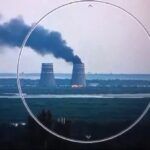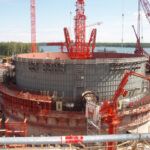Small military nuclear reactors: In need of global safeguards
By Victor Gilinsky, Henry Sokolski | June 3, 2020
 Artist’s rendering of a 1960s-era US mobile nuclear reactor program. Image credit: public domain/US Energy Dept. via Flickr.
Artist’s rendering of a 1960s-era US mobile nuclear reactor program. Image credit: public domain/US Energy Dept. via Flickr.
The US Defense Department recently awarded three contracts totaling $40 million to kick off a design competition to build small mobile nuclear reactors that can “be forward deployed with forces outside the continental United States,” including at “remote operating bases.” The notion of small reactors accompanying troops in battle raises all sorts of military, logistical, and international legal issues. But one that has received little attention is that the program shines a light on a growing loophole in the Nuclear Non-Proliferation Treaty (NPT).
It goes without saying that, if the program ever comes to fruition, such reactors on US military bases would not be subject to inspections by the International Atomic Energy Agency (IAEA)—the organization that helps implement the NPT. America’s special agreement with the agency takes account of the United States’ nuclear weapon status, and so excludes it from international inspection activities related to national security.
It may surprise readers unacquainted with the finer points of the NPT, though, that, in principle, non-nuclear weapon states could get a similar deal. The treaty does not prohibit non-nuclear weapon states from engaging in all military applications of nuclear energy, only those that involve nuclear explosives. And each safeguards agreement between a country and the IAEA includes a provision that describes this possibility.
Here is how the loophole arises: Article II of the NPT obligates non-nuclear weapon states to not obtain nuclear weapons. Article III requires IAEA safeguards “for the exclusive purpose of verification” of each country’s NPT obligations—the obligations being to not divert nuclear energy from peaceful uses to nuclear weapons or nuclear explosives.
The obligation does not extend to non-explosive military applications, so neither do IAEA safeguards or inspections. The safeguards agreement that all non-nuclear weapon states adopt with the IAEA contains a paragraph whose title says it all: “Non-Application Of Safeguards To Nuclear Material To Be Used In Non-Peaceful Activities.” The paragraph imposes a number of restrictions on the removal of nuclear materials from IAEA oversight for “non-peaceful” uses, although it still leaves a good deal open to interpretation.
That includes the dividing line between peaceful and non-peaceful. That the NPT has a problem defining “peaceful uses” should be clear from the treaty’s Article V, which speaks of “peaceful applications of nuclear explosions.” Former Brazilian ambassador Sergio Duarte, who speaks with authority as he was president of the 2005 NPT Review Conference and, before that, chairman of the IAEA Board of Governors, recently wrote, “There is no definition of ‘peaceful uses’ in any multilateral treaty on non-proliferation.”
The possibility of non-explosive military use of nuclear energy by non-weapon states is not just an academic matter—the Brazilian Navy is developing a nuclear-powered submarine and expects its reactor to be exempt from inspection while the submarine is operating. This should draw attention to the extent of the non-explosive use exception: Would such an exception apply equally to a land-based military reactor? Could a country just put a military label on a power reactor and thereby curtail international inspection? What about nuclear fuel cycle facilities?
To its credit, the IAEA insists on the narrowest interpretation, and has asserted for example that a naval submarine’s nuclear fuel on land is subject to inspection, to which Brazil has agreed. But other countries might well insist on a broader interpretation of what military or non-peaceful activities involve.
What’s curious is Brazil insists that submarine propulsion, even if done by its armed services, is itself a peaceful activity. This seems to be necessary for Brazil to maintain consistency with its adherence to the Latin American Tlatelolco treaty, pursuant to which (Article 1): “The Contracting Parties hereby undertake to use exclusively for peaceful purposes the nuclear material and facilities which are under their jurisdiction.” Hence the strange situation in which Brazil insists the submarine’s propulsion is peaceful, which would seem to require constant coverage by IAEA inspection, whereas the IAEA regards the activity as non-peaceful, and therefore eligible for an exemption.
Brazil’s submarine program is moving slowly, and it has not yet asked the IAEA for a definitive ruling, which allows time to resolve the issue. So far no other non-nuclear weapon countries besides Iran and South Korea have indicated interest in pursuing nuclear-powered submarines. The truth is that today non-nuclear submarines are superior for most tasks involving coastal waters. Israel, for example, has chosen to base its nuclear deterrent on diesel-electric powered German Dolphin submarines. So, unless a country has world-wide ambitions, it makes little sense to opt for nuclear submarines. But for those who have the resources, nuclear-powered submarines still offer an opportunity to join an exclusive and prestigious club. And even just announcing interest in nuclear submarines offers a semblance of a rationale for a domestic uranium enrichment industry.
The US program will probably go nowhere beyond the initial contracts. The real motivation apparently stems not from military need but from the Energy Department’s desperate attempt to use Defense Department funds to keep a US nuclear reactor manufacturing industry alive. In any case, it’s doubtful that the Defense Department even thought about the implications of the program for the NPT.
The State Department describes the NPT as “the cornerstone of the nuclear nonproliferation regime,” and says, “The United States remains dedicated to preserving and strengthening the nuclear nonproliferation regime, on which the treaty is based.” Whether or not the US small military reactors go forward, or the Brazilian submarines get built, the effect of treating exemptions from the NPT as normal and acceptable undermines the treaty. With the NPT Review Conference slated for early next year, this is the time to clarify these issues with a view to eliminating the IAEA exception to inspections of non-explosive military applications of nuclear energy.
Together, we make the world safer.
The Bulletin elevates expert voices above the noise. But as an independent nonprofit organization, our operations depend on the support of readers like you. Help us continue to deliver quality journalism that holds leaders accountable. Your support of our work at any level is important. In return, we promise our coverage will be understandable, influential, vigilant, solution-oriented, and fair-minded. Together we can make a difference.
















